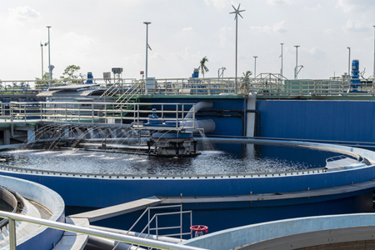Emerging Trends And Innovations Shaping The Future Of Wastewater Treatment
By Amit Ugare

The quantity and quality of freshwater, especially for residential and commercial use, are declining due to urbanization and ineffective traditional wastewater treatment (WWT) methods.
Conventional wastewater treatment methods have been partially successful in meeting standard discharge standards for decades. To enable treated wastewater for reuse in the residential, commercial, and agricultural sectors, WWT must be improved.
This article will discuss the importance of advanced wastewater treatments, the emerging trends in this domain, and the future scope of these processes.
Importance Of Advanced Wastewater Treatment
These innovative treatments are gaining attention on a global level as people, organizations, and sectors figure out how to maintain the availability and suitability of vital resources. Advanced wastewater treatment is required to lessen the effects of population growth, urbanization, industry, and the loss of drinkable water.
Wastewater treatment may only sometimes be able to effectively treat wastewater, which can lead to various difficulties, including health risks and odor problems. Wastewater is treated using novel methods to meet these issues.
Utilizing these treatment methods can help accomplish resource recovery or conservation objectives by enhancing wastewater quality beyond what can be achieved with traditional treatments. Effluents from advanced wastewater treatment plants can also be recycled, either directly or indirectly, to expand the available residential water supply.
According to the Food and Agriculture Organization of the United Nations, enough and consistent disinfection is one of the most important aspects of the modern wastewater treatment process from the standpoint of public health. Thus, nations globally are working hard to improve wastewater treatment and water quality.
Emerging Trends For Treatment Procedures
The regulations and heavy fines associated with wastewater disposal that exceed specified discharge limits are major factors that have sparked the development of new or better wastewater treatment technology. The financial stability of manufacturing facilities and businesses has been negatively impacted, which has led to the development of new or enhanced treatment solutions.
The usage of aerobic and anaerobic methods for treating organic wastewater has grown recently due to their affordability and environmental friendliness. Nevertheless, anaerobic technologies are superior since they need less energy than other technologies.
Two significant trends are:
Membrane technology
The term "membrane technology" (MT) refers to the associated scientific and engineering methods for the passage of materials, species, or components via or across membranes. This method is typically used to describe the mechanical procedures involved in separating liquid or gas streams. Membranes are categorized as a type of thin-layer barrier used in size differential separation. They are typically used in conjunction with chemical and biological treatments. However, they may be used independently in wastewater secondary treatment.
The driving force behind a typical membrane mechanism is often a semi-permeable barrier that regulates the pace of component flow by fractional penetration and rejection through holes of varying sizes. The membrane's pore size and chemical affinity determine the penetration and selective rejection, resulting in a product stream free of target components.
Microbial fuel cells (MFCs) for wastewater treatment
The utilization of MFCs for the dual purposes of wastewater treatment and bioenergy production — also known as bioelectricity — is becoming increasingly popular. Producing these bioproducts involves merely transforming wastewater's chemical and organic energy into electrical energy. An MFC device uses microorganisms as biological catalysts to convert organic matter into energy. Three main parts make up a typical MFC: electrons, separators, and electrodes. Every MFC has two electrodes, which can be divided into one or two chambers based on the design. These are fully mixed reactors when they are in operation.
Since MFCs can function in various environmental circumstances, they improve wastewater treatment and are a flexible option for decentralized applications. They make it easier to recover important resources like phosphorus and nitrogen, and their modular architecture makes it simple to integrate them into the current treatment infrastructure and scale operations. Furthermore, MFCs encourage the creation of novel, environmentally responsible solutions to problems related to water pollution.
Advanced Oxidation Processes (AOPs)
Advanced oxidation processes (AOPs) use strong oxidation procedures to break down and remove contaminants, offering substantial wastewater treatment benefits. AOPs provide improved removal of pharmaceuticals, emerging contaminants, and persistent organic pollutants that may elude traditional treatment techniques.
Examples of these approaches include photocatalysis and ozonation. These mechanisms efficiently disassemble complex compounds into innocuous byproducts by producing very reactive hydroxyl radicals.
By effectively tackling a broad spectrum of pollutants, including those resistant to conventional treatment, AOPs help enhance the quality of water. Additionally, these techniques may be used to eliminate flavor, odor, and color, improving the treated water's visual appeal.
AOPs are appropriate for various municipal and industrial waste streams because they are adaptable and can be customized to target certain impurities. AOPs promote more efficient and environmentally friendly wastewater treatment methods by improving pollutant removal, being versatile, and fulfilling strict water quality regulations.
Conclusion
Integration of artificial intelligence along with other smart technology will play a major role in various aspects of wastewater treatment in the future. Numerous innovations are taking place in the domain that improve efficiency, recovery of resources, and environmental preservation include real-time monitoring, enhanced sensors, and sustainable practices. Using decentralized treatment techniques and circular economy strategies will be crucial in tackling the world's water problems and enhancing water quality.
Predictive analytics is used in wastewater treatment to optimize processes with artificial intelligence. Machine learning algorithms examine past data on flow rates, treatment parameters, and water quality to forecast ideal circumstances. This makes it possible to modify aeration, chemical doses, and other procedures proactively to improve treatment effectiveness, lower energy usage, and lessen environmental impact.
Furthermore, abnormalities may be found by AI-driven sensors and monitoring systems, facilitating quick resolution of any problems and enhancing system dependability all around. Such innovations are anticipated to open up new avenues for the companies to earn revenues in future.
For more insight, visit https://www.transparencymarketresearch.com/wastewater-treatment-services-market.html.
